Last-Minute NYC Holiday Gift Guide 🎁
We’ve created a holiday gift guide with presents for the intrepid New Yorker that should arrive just in time—


This month, we’ve been actively covering the wonderful preservation exhibition Saving Place: 50 Years of NYC Landmarks at the Museum of the City of New York, from a preview of the exhibition, a look at the unique architectural remnants on display, to an interview with the curators. We asked co-curator Andrew Dolkart to share with us five losses and five success stories in the history of landmarking in New York City. Here were his picks:
We’ll begin with Dolkart’s picks of significant buildings that were lost before the passing of the New York City Landmarks Law in 1965.

Image via Wikimedia Commons, Library of Congress
“Penn Station, of course,” Dolkart tells us. Indeed, the loss of the original Pennsylvania Station by McKim, Meade & White is commonly referred to as the building that galvanized support for landmarking in the city. Photographs of its demolition, which took an agonizing three years, continue to haunt us today, but amazingly, remnants of the original station abound with many within the existing much-maligned structure, the subject of a popular tour we give here at Untapped Cities. In addition, Saving Place: 50 Years of NYC Landmarks has the head of an eagle that once adorned the facade of Penn Station.

Image from Library of Congress featured in Broadway
In the 19th century, the New York Produce Exchange was located at 2 Broadway across from Bowling Green. George B. Post built this brick Romanesque revival building using steel cage construction, a foreshadowing of future skyscraper technique. Prices for global commodities like oil, wheat, and corn were set here. In 1900, $15 million dollars of business passed through the exchange each day.In the 1950s, as membership in the exchange declined, the building was no longer needed. The building was demolished in 1957 and replaced by the 32-story office tower, 2 Broadway.
When standing, the Produce Exchange was more noted for its activity than for its architecture, but its pending demolition brought supporters out. Architectural historian Talbot F. Hamlin asked New Yorkers if they were “such slaves to economic pressures that they can have no say in what they see, no power to preserve what they love?” A statement that still rings true in some cases today, as it did in in 1953.

Brooklyn Savings Bank. Photo via Wikimedia Commons
This Neoclassical bank in Brooklyn Heights was demolished just one year before the New York City Landmarks law was passed and one year before Brooklyn Heights was named a National Historic Landmark District. The bank stood at the intersection of Clinton and Pierrepont Streets and was built by local Brooklyn architect, Frank Freeman, who was inspired by the Neoclassical style at the World’s Columbian Exposition in Chicago. Journalist Norman Oder called its demolition one of “the great landmark losses in New York history.” Like Penn Station for New York City in general, the loss of the Brooklyn Savings Bank helped create community-up support for the landmarking of the Brooklyn Heights district.
The next two losses occurred after the passing of the New York City Landmarks Law:
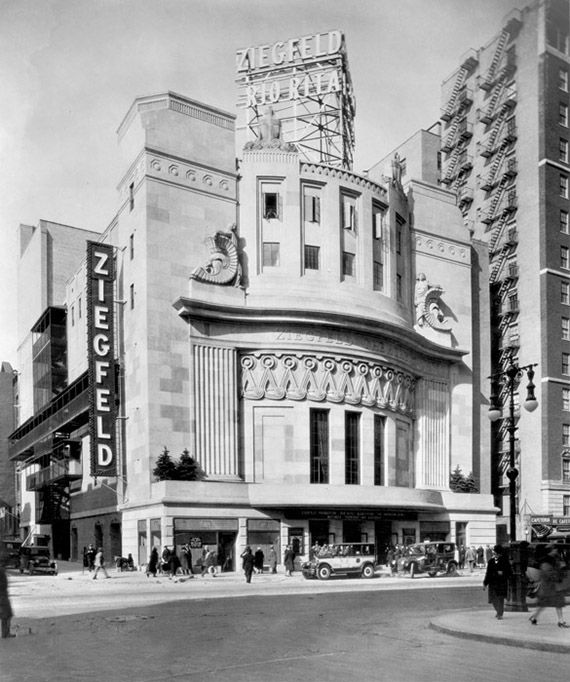 Photo from Museum of the City of New York Collection
Photo from Museum of the City of New York Collection
As history often comes full circle, the current Ziegfeld Theatre, built a few hundred feet away and three years after the demolition of the original, may be closing. The original Ziegfeld Theatre was built in 1927 by impresario Florence Ziegfeld, with backing from William Randolph Hurst at the corner of Sixth Avenue and 54th Street. Joseph Urban, a favorite designer of Ziegfeld conceived of the structure, with consultation by famous theater architect Thomas Lamb. As this was show business, it’s not surprising that Urban’s architecture was derided by the architectural critics of the time as overly theatrical, and flamboyant even. But as Arnold Aronson writes in Architect of Dreams: The Theatrical Vision of Joseph Urban:
“Urban believed that public space should be designed with the same sense of total environment and aesthetic pleasure with which one created a stage setting…Following the metaphor to its logical end, his architectural projects could all be seen as ‘theaters,’ an impression reinforced by his frank assertion that a building facade was a form of advertising – a marquee.”
 Source: New York Public Library
Source: New York Public Library
The Singer Building at Broadway and Liberty Street was the tallest building in the world for 18 months. Built by architect Ernest Flagg in 1908, the building utilized a setback tower atop 12-story a base. Flagg was an advocate of new regulations for skyscrapers and some of his ideas were incorporated into the 1916 zoning regulation. Unfortunately, the setback of the Singer Building is precisely what doomed it. Its narrow tower portion rendered it economically unviable for office space and it became the tallest building ever demolished in 1968. Interior photos were taken before demolition, capturing the marble and bronze lobby.
The landmarks law is also a story of great successes, setting a framework for preservation and development in New York City. For the 5 successes of the Landmarks Law, Dolkart has chosen concepts, rather than buildings.
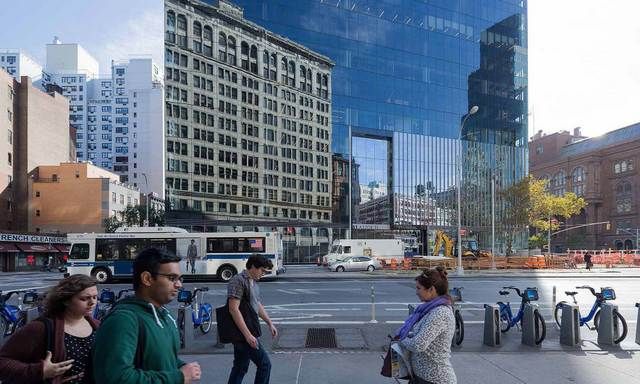
Photograph from Saving Place: 50 Years of NYC Landmarks by Iwan Baan
First, Dolkart tells us, the major success is the “the survival and evolution of the law itself.” As the exhibition Saving Place: 50 Years of NYC Landmarks shows, the New York City Landmarks Law is distinctively New York, forged through bottom-up community struggle over the course of decades, the results creating an architectural coexistence of old and new, which push architects and designers to devise increasingly creative solutions to integrate new construction in landmark neighborhoods.
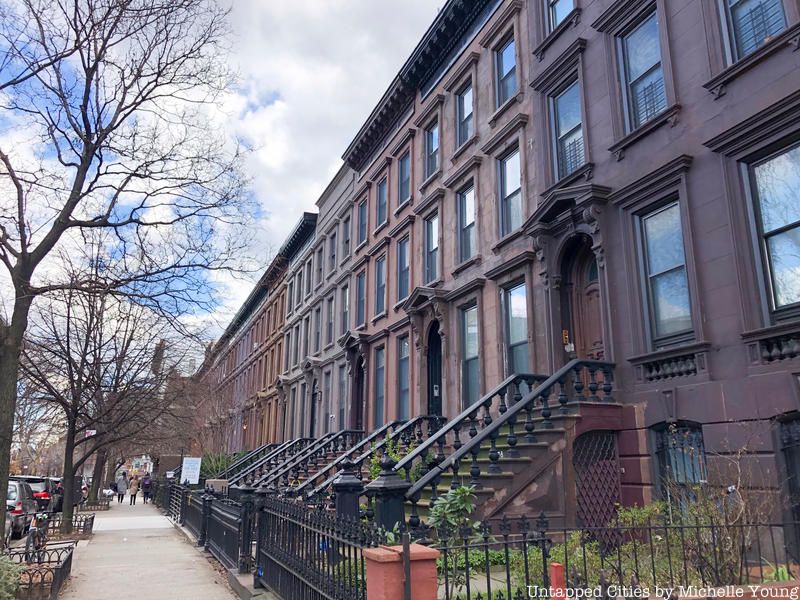
Indeed, Dolkart feels that another major success of the landmarks law is the community-level support that has defined the movement since the beginning. He tells Untapped Cities, “grass-roots support from people in the city has resulted in the designation of substantially sized historic districts and the continuing forceful lobbying of people in neighborhoods such as Bedford-Stuyvesant for additional designations.”

Woolworth Building nearing completion. Photo from Library of Congress
While we take the skyscrapers of New York City, like the Woolworth Building, Flatiron Building, and Chrysler Building, as given landmarks, these were not obvious choices for designation early on. To Dolkart, a third success of the landmarks law was the designation of the great skyscrapers. He tells us that today, these buildings are “a defining part of New York City’s character. These skyscrapers were of little interest to the early commission and their designation was often not supported by owners at first, but what would New York be without them?” Indeed, as curator Donald Albrecht also mentioned in our curator interview, the preservation movement in the 1910s and 1920s was focused primarily on buildings that were considered historically significant, “the ‘George Washington slept here’ phenomenon.”
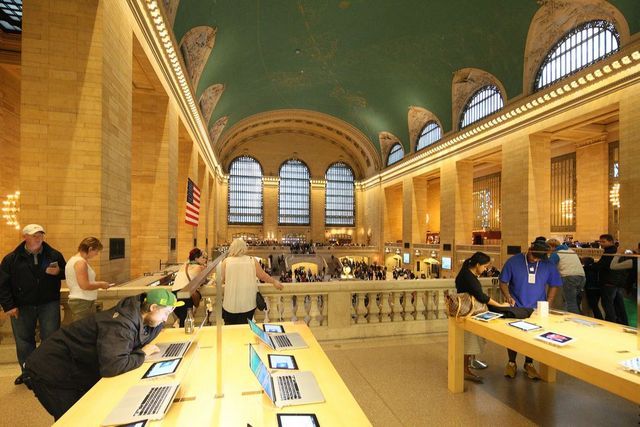
Photograph from Saving Place: 50 Years of NYC Landmarks by Iwan Baan
Fourth, Dolkart says one of the major successes was “The Penn Central decision.” This case began when the New York City Landmarks Commission denied a proposal from Penn Central to build a skyscraper on top of Grand Central Terminal. The case went all the way to the Supreme Court, after various appeals and reversals, with the high court determining that the landmark restriction on Grand Central did not amount to a “taking,” meaning it did not prevent Penn Central from receiving a “reasonable return” on its property. This new method, evaluating a takings case on “reasonable return,” set a new standard for land use law cases and was a significant win for preservationists.
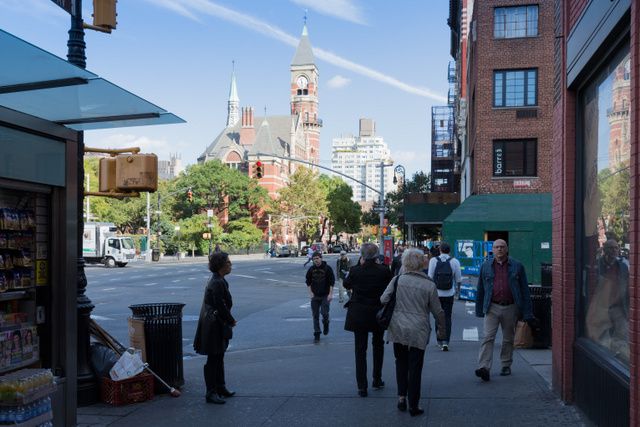
Photograph from Saving Place: 50 Years of NYC Landmarks by Iwan Baan
As a final success story, Dolkart gives credit to the Landmarks Preservation Commission and “their ability to review new construction and accept buildings that they deem appropriate, including those of very contemporary design, and reject those that are detrimental to an individual building or a historic district. These are often controversial decisions that the Commission takes very seriously.” This has allowed the Landmarks Law in New York City to have a certain level of flexibility, led by appointed delegates.
Saving Place: 50 Years of New York City Landmarks will remain on view through Sunday, September 13th 2015 at the Museum of the City of New York. Read on for our interview with curators Donald Albrecht and Andrew Dolkart, our preview of the exhibit, and a look at the architectural remnants featured in the exhibit.
A book, Saving Place: 50 Years of New York City Landmarks has been published by Monacelli Press in conjunction with the exhibition.
Subscribe to our newsletter